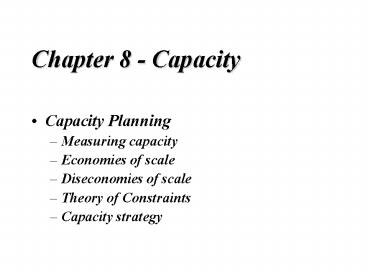Chapter 8 - Capacity PowerPoint PPT Presentation
Title: Chapter 8 - Capacity
1
Chapter 8 - Capacity
- Capacity Planning
- Measuring capacity
- Economies of scale
- Diseconomies of scale
- Theory of Constraints
- Capacity strategy
2
Utilization
Fabrication can make 100 engines/day Management
wants 45 engines/day Currently producing 50
engines/day
50 100
Utilizationpeak x 100 50
50 45
Utilizationeffective x 100 111
Example 8.1
3
Capacity Bottlenecks
Figure 8.2
4
Theory of Constraints
- Identify the system bottleneck(s)
- Exploit the bottleneck(s)
- Subordinate all other decisions to step 2
- Elevate the bottleneck(s)
- Do not let inertia set in
5
Economies and Diseconomies of Scale
250-bed hospital
750-bed hospital
500-bed hospital
Average unit cost (dollars per patient)
Diseconomies of scale
Economies of scale
Output rate (patients per week)
Figure 8.3
6
Capacity Strategies
Forecast of capacity required
Planned unused capacity
Capacity increment
Capacity
Time between increments
Time
(a) Expansionist strategy
Figure 8.4
7
Capacity Strategies
Forecast of capacity required
Planned use of short-term options
Capacity increment
Capacity
Time between increments
Time
(b) Wait-and-see strategy
Figure 8.4
8
Linking Capacity and Other Decisions
- Competitive Priorities
- Quality Management
- Capital Intensity
- Resource Flexibility
- Inventory
- Scheduling
9
- A Systematic Approach to Capacity Decisions
- Step 1 Estimate Capacity Requirements
- Step 2 Identify Gaps
- Step 3 Develop Alternatives
- Step 4 Evaluate the Alternatives
- Qualitative Concerns
- Quantitative Concerns
10
Tools for Capacity Planning
- Waiting- Line Models (Suppl C)
- Simulation (Suppl D)
- Decision Trees
11
Capacity Decisions
Decision Trees
Low demand 0.40
70
Dont expand
90
High demand 0.60
Small expansion
Expand
135
Low demand 0.40
Large expansion
40
High demand 0.60
220
Figure 8.4
PowerShow.com is a leading presentation sharing website. It has millions of presentations already uploaded and available with 1,000s more being uploaded by its users every day. Whatever your area of interest, here you’ll be able to find and view presentations you’ll love and possibly download. And, best of all, it is completely free and easy to use.
You might even have a presentation you’d like to share with others. If so, just upload it to PowerShow.com. We’ll convert it to an HTML5 slideshow that includes all the media types you’ve already added: audio, video, music, pictures, animations and transition effects. Then you can share it with your target audience as well as PowerShow.com’s millions of monthly visitors. And, again, it’s all free.
About the Developers
PowerShow.com is brought to you by CrystalGraphics, the award-winning developer and market-leading publisher of rich-media enhancement products for presentations. Our product offerings include millions of PowerPoint templates, diagrams, animated 3D characters and more.

